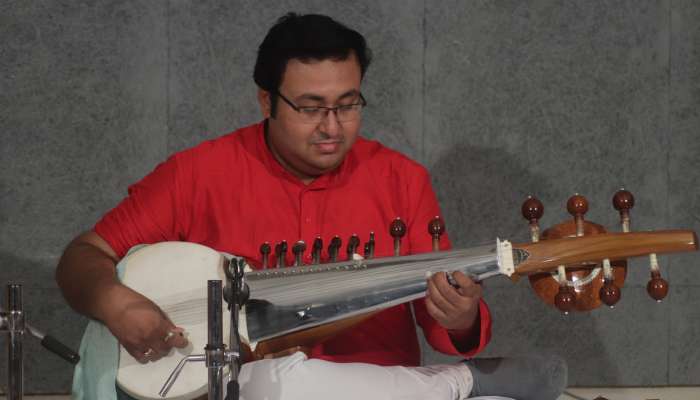
MUSCAT: The haunting resonance of the Oud, one of the oldest stringed instruments in the Arab world, continues to echo across generations. But few may know that its musical lineage spans continents — from Arabia to Afghanistan, and from there to the heart of India, evolving into the Sarod, now a cornerstone of Indian classical music.
At the crossroads of this journey stands Joydeep Mukherjee, an eminent Indian musician and cultural historian based out of eastern Indian city of Kolkata, who has dedicated his life to reviving these forgotten connections — not only through performance, but also through painstaking restoration and research.
“The lute has long held its place on the world stage,” said Mukherjee in a chat with Times of Oman.
“But it is the Arabian Oud and Afghan Rabab that shaped the journey of the fretless lute family. These instruments didn’t just travel — they transformed, enriched by the musical soil of every region they touched.”
The story of this transformation began in 6th and 7th century Arabia, where the Oud and Rabab gained prominence. From the Middle East, they journeyed eastward, entering Afghanistan, where the Rabab emerged as a distinct and popular folk instrument.
By the 13th century, Afghan soldiers and horse traders brought the Rabab to India — an instrument once played while marching into battle, now seeking new life in a land of melody.
Over time, North Indian musicians began experimenting with the Afghan Rabab, attempting to adapt it to Indian ragas.
Perhaps the most pivotal transformation came in the 16th century, when Miya Tansen, legendary court musician of Emperor Akbar, reimagined the Rabab to better serve Indian classical music. This larger, deeper version came to be known as the “Dhrupad Rabab”, later evolving into the “Tanseni” or “Seni Rabab.”
The next century saw Jaffer Khan, a descendant of Tansen, replace the Rabab’s wooden components with steel and wood, creating a new instrument — the Sursingar.
Parallel innovations followed in the central Indian city of Gwalior, where Hyder Khan and Ghulam Ali Khan Bangash introduced metallic strings and steel fretboards, naming the refined instrument Sarod — meaning “sweet sound” in Persian.
It was Ghulam Ali’s son Nanne Khan, and later his descendants — most notably Hafiz Ali Khan and the globally renowned Amjad Ali Khan — who brought the Sarod to international acclaim.
Their interpretations made the Sarod not only a household name in Indian music but also a symbol of Indo-Middle Eastern musical kinship.
Yet, parallel innovations were quietly flourishing elsewhere. In Shahjahanpur, Murad Ali deepened the Sarod’s tone by adopting metallic strings.
His lineage — Abdullah Khan and Mohammed Ameer Khan — made further refinements, even developing the Sur-Rabab, a hybrid of Sursingar and Tanseni Rabab, in the 1880s in British Bengal.
But perhaps no one explored the full potential of these instruments like Radhika Mohan Maitra during the mid-20th century.
A visionary of the Shahjahanpur Gharana, he created multiple unique hybrids: the Mohanveena (Sarod + Sursingar), the Dilbahar (Sarod + Surbahar), and Nabadeepa (Sursingar + Sarangi).
Parallel to these developments, Ustad Wazir Khan, a descendant of Tansen’s daughter and court musician of Rampur, trained the iconic Baba Allaudin Khan. The latter revolutionised the Sarod’s design — enlarging the sound box, lengthening the body, and increasing the number of sympathetic strings. These changes formed the blueprint for what would become the Senia Maihar Gharana’s Sarod — played by Ali Akbar Khan, Bahadur Khan, and Sharan Rani, among others.
The evolutionary arc continued with Buddhadeb Dasgupta, principal disciple of Radhika Mohan Maitra.
In the 1960s and ‘70s, he introduced a child-friendly 36-inch Sarod model, further democratising access to this once-royal instrument.
Today, when many classical musicians chase stage time and limelight, Joydeep Mukherjee has chosen a more introspective path — tracing the past, reviving forgotten sounds, and giving life to instruments that were fading into silence.
A grand disciple of Radhika Mohan Maitra, Mukherjee has, over the past 15 years, revived and restored fretless lutes like the Tanseni Rabab, Sursingar, Sur-Rabab, and Mohanveena.
In 2025, he completed the restoration of every significant Sarod variant from the Shahjahanpur Gharana, spanning more than two centuries of innovation — from Murad Ali to Buddhadeb Dasgupta.
“Music is universal. It should not be restricted by geography,” Mukherjee said.
“The Middle East has shaped India’s musical traditions for over a thousand years. There was cultural intermingling for millennia. My work is a tribute to that shared history.”
Mukherjee hopes that his revival of these instruments sends a message across borders.
“To those in the Arab world who cherish the Oud and Rabab, know that these instruments live on — not just in memory, but in sound, performance, and evolution.”
In a time when tradition and innovation often stand at odds, Mukherjee is proving they can co-exist. Music is not just sound — it is memory, migration, and meaning. Through his hands, the lute family sings again, telling stories that span deserts, courts, and centuries.